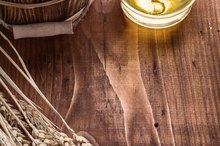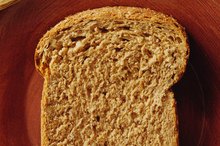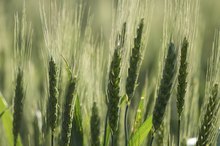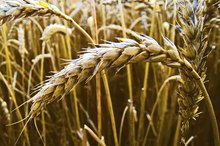No Wheat or Dairy Diet
Wheat and dairy are staples in many American diets and most people can eat them without experiencing any problems. However, health conditions such as celiac disease require avoiding wheat, and diets for autism and allergies recommend eliminating both wheat and dairy. Some diets for weight loss, such as the Paleo diet, also recommend eliminating wheat and dairy. Check with your doctor before beginning any restrictive diet.
History
Early humans did not eat grain or dairy. Instead, they foraged for wild fruits, berries and nuts and hunted for meat. People began eating grain and dairy as a result of the Agricultural Revolution, which occurred approximately 10,000 years ago. Growing wheat and raising dairy cattle required farmers to stay in one place. Proponents of dairy- and wheat-free diets, such as the Paleo Diet, believe that it is not healthy to eat grain or dairy now because early humans did not do so.
- Early humans did not eat grain or dairy.
- Proponents of dairy- and wheat-free diets, such as the Paleo Diet, believe that it is not healthy to eat grain or dairy now because early humans did not do so.
Benefits
Signs & Symptoms of Wheat & Whole Grain Allergies
Learn More
Wheat- and dairy-free diets are crucial if you have an allergy to both. The protein in wheat responsible for allergies is gluten, and the protein in dairy is called casein. Eliminating dairy and wheat may improve skin conditions such as eczema and digestive disorders such as Crohn's disease. The Feingold diet recommends avoiding both gluten and casein and may treat symptoms of attention-deficit and hyperactivity disorder, or ADHD. A gluten-free, casein-free diet is also a controversial treatment for autism.
- Wheat- and dairy-free diets are crucial if you have an allergy to both.
- Eliminating dairy and wheat may improve skin conditions such as eczema and digestive disorders such as Crohn's disease.
Wheat and Dairy Foods
Wheat- and dairy-free foods must avoid many common foods. Among the foods that contain wheat include:
- bread
- pasta
- muffins
- crackers
- cookies
- although gluten-free alternatives made with other flours are possible
Dairy foods include milk, ice cream, butter, sour cream and yogurt 1. Wheat and milk may be in processed foods under other names, which include
- caseinate
- gluten
- whey
- hydrolyzed vegetable protein
- caramel color
- lactalbumin
- lactose
- brewers yeast
- farina
- modified food starch
- monosodium glutamate
Acceptable Alternatives
Dairy Allergies and Mucus
Learn More
Many foods can still be eaten on a dairy-free, wheat-free diet. Acceptable fruits include:
- apples
- oranges
- bananas
- peaches
- pears
- grapes
- all types of berries
Acceptable vegetables include
- carrots
- beans
- avocado
- peppers
- asparagus
- squash
- lettuce
- tomatoes
- onions
Potatoes and sweet potatoes are not acceptable if you are following the Paleo diet. Rice, barley, corn and oats are acceptable grains in most cases and provide the basis of wheat-free alternative flours.
Warnings
Wheat and dairy both contain protein, which could make it more difficult to obtain enough protein in your diet, especially if you do not eat meat. Insufficient protein intake can lead to muscle loss. Dairy also contains calcium, which is essential for strong bones; you may be at risk of osteoporosis and weak bones if you do not consume enough calcium from vegetable sources.
Related Articles
References
- University of Maryland Medical Center: Food Allergy
- Cianferoni A. Wheat allergy: diagnosis and management. J Asthma Allergy. 2016;9:13-25. doi:10.2147/JAA.S81550
- Salcedo G, Quirce S, Diaz-perales A. Wheat allergens associated with Baker's asthma. J Investig Allergol Clin Immunol. 2011;21(2):81-92.
- Scherf KA, Brockow K, Biedermann T, Koehler P, Wieser H. Wheat-dependent exercise-induced anaphylaxis. Clin Exp Allergy. 2016;46(1):10-20. doi:10.1111/cea.12640
- Pacharn P, Vichyanond P. Immunotherapy for IgE-mediated wheat allergy. Hum Vaccin Immunother. 2017;13(10):2462-2466. doi:10.1080/21645515.2017.1356499
- Czaja-Bulsa G, Bulsa M.What Do We Know Now about IgE-Mediated Wheat Allergy in Children?Nutrients. 2017 Jan 4;9(1). pii: E35. doi: 10.3390/nu9010035.
- Pacharn P, Vichyanond P.Immunotherapy for IgE-mediated wheat allergy.Hum Vaccin Immunother. 2017 Oct 3;13(10):2462-2466. doi: 10.1080/21645515.2017.1356499.
Writer Bio
Holly Case has written professionally since 2000. She is a former contributing editor for "ePregnancy" magazine and a current editor for a natural food magazine. She has extensive experience writing about nutrition, pregnancy, infertility, alternative medicine, children's health and women's health issues. Case holds a Bachelor of Arts in sociology and professional writing from Saginaw Valley State University.









